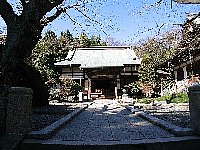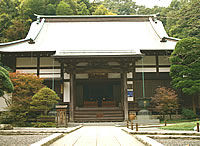Hokokuji
Historical Overview
 This Zen temple is relatively new in Kamakura as it was built in 1334,
a year after the Kamakura Shogunate came to an end. The founder, Ietoki Ashikaga
(his birth and death years are unknown), was the grandfather of Takauji
Ashikaga, the first Shogun of the Ashikaga regime or the Muromachi Period
(1336-1573)
This Zen temple is relatively new in Kamakura as it was built in 1334,
a year after the Kamakura Shogunate came to an end. The founder, Ietoki Ashikaga
(his birth and death years are unknown), was the grandfather of Takauji
Ashikaga, the first Shogun of the Ashikaga regime or the Muromachi Period
(1336-1573)
Founding priest Tengan (1273-1335) joined the school of Priest Sogen Mugaku
(1226-1286), the founding priest of Engakuji, at the age of 13. He went to China
in 1320 to learn more about Zen and stayed there for nine years. After returning
to Kamakura in 1329, he was enrolled in Jomyoji, another Zen temple. When Ietoki
Ashikaga resolved to erect the Temple, Priest Tengan was named the founding
priest.
Hokokuji reminds us of the bloody struggles erupted among the Shogun,
governors and vice-governors in the early Muromachi Period. With the collapse of
the Hojo regime in 1333, Takauji Ashikaga established the Muromachi Shogunate
placing the government office in Muromachi district in Kyoto. (Hence the name of
the Muromachi Period). As Kamakura was still an important stronghold in eastern
Japan, Takauji appointed his second son Motouji Ashikaga (1340-1358) to be the
first governor of Kamakura to control the Kanto (Tokyo and its neighboring
prefectures) region. Motouji nominated Noriaki Uesugi (1306-1368) for
vice-governor, whose ancestor came to Kamakura from Kyoto together with the
Sixth Shogun Munetaka. Thereafter, the two chairs were held by successive
members of the two families, during which period, however, both were almost
always at odds with each other.
 It was in the early 15th century that a Hokokuji-related tragedy broke
out. Mochiuji Ashikaga (1398-1439) assumed the fourth governorship at the age of
13 upon death of his father. As Mochiuji did not follow suggestions made by the
vice-governor Ujinori Uesugi (?-1417) at all, both turned hostile to each other
to the extent that Ujinori was forced to step down. Mochiuji named Norimoto
Uesugi (1392-1418) as a new vice-governor. Though Ujinori and Norimoto were from
the same faction, they had not been getting along well with each other, and
therefore, Ujinori harbored further hostility toward Mochiuji. In capital Kyoto,
Yoshitsugu Ashikaga (1394-1418), younger brother of Fourth Shogun Yoshimochi
Ashikaga (1358-1408), was secretly trying to overthrow the Shogunate in an
attempt to take over the seat of the Shogun himself. He sent a message to
Mitsutaka Uesugi, uncle of Mochiuji, and Ujinori in Kamakura urging them to
carry out a coup d'etat in Kamakura. Chances were for Mitsutaka to become the
governor in replacement of Mochiuji. Both agreed to the Yoshitsugu's secret
proposal and they made a surprise attack one night on Mochiuji's residence.
Mochiuji was barely able to escape the attack and asked Shogun Yoshitsugu for
help. Overthrowing attempt was by no means acceptable to Yoshimochi. He
immediately sent his army to Kamakura to kill Mitsutaka and Ujinori. Both were
caught in the end and forced to commit harakiri.
It was in the early 15th century that a Hokokuji-related tragedy broke
out. Mochiuji Ashikaga (1398-1439) assumed the fourth governorship at the age of
13 upon death of his father. As Mochiuji did not follow suggestions made by the
vice-governor Ujinori Uesugi (?-1417) at all, both turned hostile to each other
to the extent that Ujinori was forced to step down. Mochiuji named Norimoto
Uesugi (1392-1418) as a new vice-governor. Though Ujinori and Norimoto were from
the same faction, they had not been getting along well with each other, and
therefore, Ujinori harbored further hostility toward Mochiuji. In capital Kyoto,
Yoshitsugu Ashikaga (1394-1418), younger brother of Fourth Shogun Yoshimochi
Ashikaga (1358-1408), was secretly trying to overthrow the Shogunate in an
attempt to take over the seat of the Shogun himself. He sent a message to
Mitsutaka Uesugi, uncle of Mochiuji, and Ujinori in Kamakura urging them to
carry out a coup d'etat in Kamakura. Chances were for Mitsutaka to become the
governor in replacement of Mochiuji. Both agreed to the Yoshitsugu's secret
proposal and they made a surprise attack one night on Mochiuji's residence.
Mochiuji was barely able to escape the attack and asked Shogun Yoshitsugu for
help. Overthrowing attempt was by no means acceptable to Yoshimochi. He
immediately sent his army to Kamakura to kill Mitsutaka and Ujinori. Both were
caught in the end and forced to commit harakiri.
Mochiuji was thus able to restore the law and order in Kamakura as a
governor. Nevertheless, he did not go well with new vice-governor Norizane
Uesugi (1410-1466) either. Back at the time, children whose age reached 13 were
celebrated and given a new adult name in recognition of coming of age. In most
cases, governors' children received one Chinese character of the Shogun's name.
Look at the first names of Shogun in Muromachi Period. How many names start with
'Yoshi'. In the meantime, when Mochiuji's son reached the age, he
named the son 'Yoshihisa' without ever consulting with Sixth Shogun Yoshinori
(1394-1441) in Kyoto. Mochiuji ignored the traditional practice. Vice Governor
Norizane was enraged and left Kamakura in a protest against him for Gunma
Prefecture where he was the lord of manor. Mochiuji interpreted his action as a
revolt and sent army to kill him. However, Shogun Yoshinori in Kyoto sided with
Norizane and ordered the Shogunate army to assault the Mochiuji's residence.
Mochiuji was no match for the Shogunate. He and his son Yoshihisa had no choice
but to kill themselves. Yoshihisa's suicide ritual took place right here at
Hokokuji. It was in 1439 and he was only 13 years old. With his death, the
Ashikaga governorship in Kamakura ended in tragedy. (Mochiuji performed
seppuku at a temple near Zuisenji, which no longer exists.)
A 50.7 centimeters tall statue of Shaka Nyorai is
enshrined as the main object of worship. It was fashioned in the mid-14th
century and reflects the Sung style carvings in China. The statue of Sho
Kan'non, or Arya-avalokitesvara in Skt., ranks tenth of the Kamakura
Thirty-Three Kan'non Pilgrimage. The original statue is, however, preserved at
the Kamakura Museum. Also installed is a sedentary statue of founding priest Eko
Tengan carved in 1347, whose posthumous Buddhist title is Butsujo-Zenji.
Kashodo Hall
Adjacent to the main hall is
Kashodo. Kasho, or Kasyapa in Skt., is one of the Ten Great
Disciples of Sakyamuni. His statue was once enthroned in this hall, but was lost
by fire in 1891. The sculptor was Joko Takuma (birth and death years unknown),
one of the Takuma school sculptors. They were a local artists group including
painters with excellent technique, and lived around here at Takuma valley. The
Temple is therefore commonly referred to as 'Takuma-dera.'
119
Gorinto
Near the bell, a cluster of small gorinto (five-tier
tombs) are standing with a large one in the center. At the time of the Hojo
regime's collapse in 1333, there was a fierce battle in Kamakura, and thousands
of warriors were killed. Some of their remains were brought to the Temple and
buried here. The gorinto are their tombs.
Bamboo Garden
Entrance is located on the left-side of the main
hall. In the back yard are a cool bamboo (Phyllstachys pubescens) forest and a
beautifully arranged garden often seen at Zen temples. Right here the founding
priest built a hermitage called 'Kyuko-an'. Stone statues of the Lord
Buddha and stone lanterns are found here and there. At the south corner, there
is a tea-house, where Japanese powdered tea is served.
At the west end
of the yard are large yagura (caves) and ashes of Ashikaga family
including those of Ietoki and Yoshihisa are reportedly buried. The Temple has
since served the family to console the souls of the departed, many of them died
in tragedy.
Buddhism
 This Zen temple is relatively new in Kamakura as it was built in 1334,
a year after the Kamakura Shogunate came to an end. The founder, Ietoki Ashikaga
(his birth and death years are unknown), was the grandfather of Takauji
Ashikaga, the first Shogun of the Ashikaga regime or the Muromachi Period
(1336-1573)
This Zen temple is relatively new in Kamakura as it was built in 1334,
a year after the Kamakura Shogunate came to an end. The founder, Ietoki Ashikaga
(his birth and death years are unknown), was the grandfather of Takauji
Ashikaga, the first Shogun of the Ashikaga regime or the Muromachi Period
(1336-1573) It was in the early 15th century that a Hokokuji-related tragedy broke
out. Mochiuji Ashikaga (1398-1439) assumed the fourth governorship at the age of
13 upon death of his father. As Mochiuji did not follow suggestions made by the
vice-governor Ujinori Uesugi (?-1417) at all, both turned hostile to each other
to the extent that Ujinori was forced to step down. Mochiuji named Norimoto
Uesugi (1392-1418) as a new vice-governor. Though Ujinori and Norimoto were from
the same faction, they had not been getting along well with each other, and
therefore, Ujinori harbored further hostility toward Mochiuji. In capital Kyoto,
Yoshitsugu Ashikaga (1394-1418), younger brother of Fourth Shogun Yoshimochi
Ashikaga (1358-1408), was secretly trying to overthrow the Shogunate in an
attempt to take over the seat of the Shogun himself. He sent a message to
Mitsutaka Uesugi, uncle of Mochiuji, and Ujinori in Kamakura urging them to
carry out a coup d'etat in Kamakura. Chances were for Mitsutaka to become the
governor in replacement of Mochiuji. Both agreed to the Yoshitsugu's secret
proposal and they made a surprise attack one night on Mochiuji's residence.
Mochiuji was barely able to escape the attack and asked Shogun Yoshitsugu for
help. Overthrowing attempt was by no means acceptable to Yoshimochi. He
immediately sent his army to Kamakura to kill Mitsutaka and Ujinori. Both were
caught in the end and forced to commit harakiri.
It was in the early 15th century that a Hokokuji-related tragedy broke
out. Mochiuji Ashikaga (1398-1439) assumed the fourth governorship at the age of
13 upon death of his father. As Mochiuji did not follow suggestions made by the
vice-governor Ujinori Uesugi (?-1417) at all, both turned hostile to each other
to the extent that Ujinori was forced to step down. Mochiuji named Norimoto
Uesugi (1392-1418) as a new vice-governor. Though Ujinori and Norimoto were from
the same faction, they had not been getting along well with each other, and
therefore, Ujinori harbored further hostility toward Mochiuji. In capital Kyoto,
Yoshitsugu Ashikaga (1394-1418), younger brother of Fourth Shogun Yoshimochi
Ashikaga (1358-1408), was secretly trying to overthrow the Shogunate in an
attempt to take over the seat of the Shogun himself. He sent a message to
Mitsutaka Uesugi, uncle of Mochiuji, and Ujinori in Kamakura urging them to
carry out a coup d'etat in Kamakura. Chances were for Mitsutaka to become the
governor in replacement of Mochiuji. Both agreed to the Yoshitsugu's secret
proposal and they made a surprise attack one night on Mochiuji's residence.
Mochiuji was barely able to escape the attack and asked Shogun Yoshitsugu for
help. Overthrowing attempt was by no means acceptable to Yoshimochi. He
immediately sent his army to Kamakura to kill Mitsutaka and Ujinori. Both were
caught in the end and forced to commit harakiri.